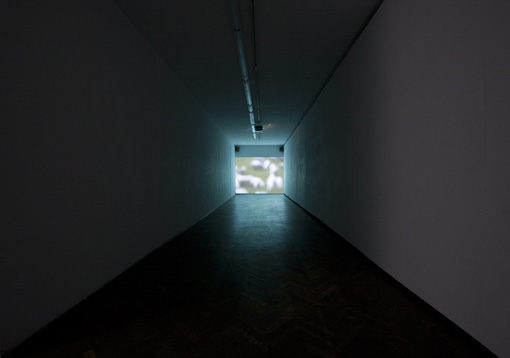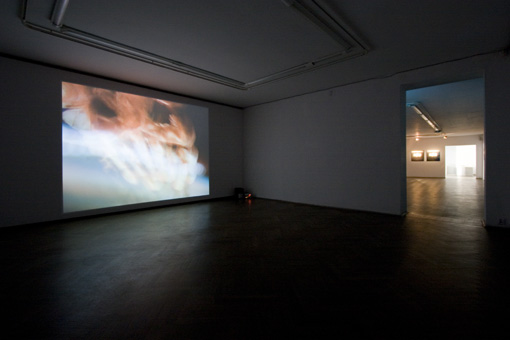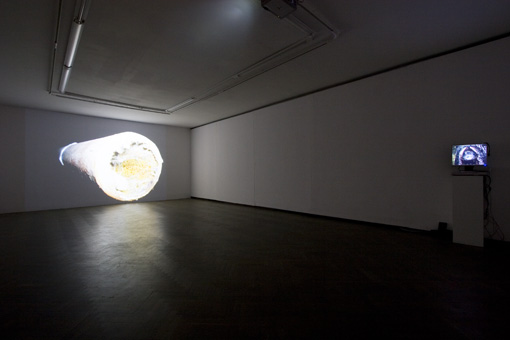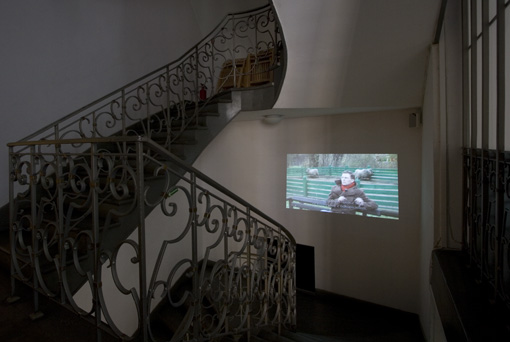DANIEL RUMIANCEW – Low pressure, gusty wind
Anna Łazar
Shame elevated to the highest rank. About Daniel Rumiancew’s works
For him, irony is not a means of defense against the world but a way of developing ethical sensitivity. It only serves to protect from the trap laid by dogmatism; it offers a sense of security by precluding the possibility of being infinitely seduced by a certain lexicon. This is how he shields himself from the fundamentalism of Knowledge and Faith and how he creates favorable conditions for being ready to venture upon the process of self-identification once again by means of a dialogue with other lexicons. The ultimate aim of an ironist entails a repeated attempt to create himself anew having casually selected some values which are commonly known not to be absolute.[1]
The title of the exhibition Niskie ciśnienie, porywisty wiatr (Eng. ‘Low Pressure, Gusty Wind’) sounds like a weather forecast, but low (blood) pressure is also a medical condition which presents with the following symptoms: vertigo, cold feet and hands, drowsiness and lack of energy. In Polish slang, the phrase ‘low pressure’ also refers to poor motivation, reluctance to succumb to external demands, and a refusal to take strenuous effort. On the contrary, gusty wind reflects, inspiration, untamed emotions, romantic fever, i.e. the willingness to carry the world on your shoulders. Daniel Rumiancew’s works entail all these levels of interpretation. The artist uses an idiolect which is, on the one hand, free from rhetorical zeal as well as unrestrained by the kind of persuasion that leads to precise conclusions formulated beforehand by the author of the message. Yet on the other hand, his idiolect does involve garish and exaggerated metaphors. The material Rumiancew uses comprises prearranged situations which astonish with their extraordinary nature, as well as all-too-familiar every day images that are hardly ever employed by popular culture even though they are recognizable to an average viewer rooted in the European tradition. No matter how familiar with the context, the viewer is compelled to define it anew. Rumiancew refers to the type of perception which is ontogenetic and as such, unhampered by any intermediaries. He constructs stories which belong to a different realm than the ones which the media have taught us to get used to. With the exception of Tańcząc ze łzami w oczach (Eng. ‘Dancing with Tears in the Eyes’) which is a conventional documentary, he uses prolonged shots in which narration and eventfulness are reduced to the minimum. The stipulation that the viewer concentrates on one image may result either in the unraveling, provoking and generating of deeper layers of meaning, or simply in a sense of boredom. If the viewer’s attention remains fixed, it soon becomes evident that the immobility is, in fact, confusing; that the seemingly narrow frame conceals an interplay of varied messages and tensions.
The artist defines the images he selects as embarrassing, rejected, even ‘uncool’. Why is it then that they keep recurring in his works? After all it is hardly a prestigious task to mock what has already been mocked, or to reject what has already been rejected. It seems, however, that in the reiteration of the embarrassing and the mocked lurks a rebellion against reducing the visual space to matters which are assumed to be vital and worth committing to. Rumiancew strives to find room for a person who has no need of taking any stance as far as the entire society is concerned. He negotiates a space for an individual whose incongruity with the convention is rather neurotic than spectacular. Rumiancew drew precise conclusions from reading such texts as Artur Żmijewski’s manifesto: I have recently read Artur Żmijewski’s manifesto entitled “Applied Social Arts” published in Krytyka Polityczna (Eng. ‘Political Critique’) and it seems to me that an artist should do what he feels like doing, for instance get involved. Meanwhile, Żmijewski encourages us to focus our intentions explicitly on social matters and applied arts; and to do it simultaneously. The most significant conclusion that I have drawn after having read Żmijewski’s text is that if you need to concentrate on matters crucial for the society, you should toil over them regardless of the fact that they are unpopular, seemingly resolved, or excessively exploited. It is only in this sense that this manifesto could serve as a justification for what I have done, and perhaps for what I am still about to do, as far as the issues of gender are concerned.[2]
Dynamic and attention-grabbing elements emerge victorious in the perception of the world which involves the agency of an intermediary . When everyday life, lack of originality, and kitsch that has been exposed do not start from the position of a quotation, or a statement about oneself, they are either renounced or marginalized. Nevertheless, Daniel Rumiancew enters into these seemingly barren lands. In Mglisty dzień (Eng. ‘Foggy Day’; 2006/2008) he films herds of sheep on a mountain pasture in a Impressionist manner, manipulating the focus until the image becomes completely blurred. The blurry specks of white set against a green background may be identified as sheep only thanks to the distinct shape of the bells which remains in sharp contrast with the hazy image, as well as thanks to the sound of the sheep bleating. The author’s commentary reveals that this is how he reworks the wistfulness for the happy days of his childhood to which there is no way of returning.
Everyday issues also constitute the focal point of another Rumiancew’s work entitled Widok z okna (Eng. ‘View out of a Window’; 2007/2008). Looking at something out of a window is a situation in which a person is suspended between two realms: the private space of a flat or a house and the public space outside. It was Józef Robakowski who endeavored to comment upon social reality using image and word in a work entitled Z mojego okna (Eng. ‘Out of My Window’), which it had taken him twenty years to create (1978 – 1999). He managed to capture the traces of his own story, the stories of his neighbors, and even of his country. Out of his window, Rumiancew sees a birch tree tossed by the wind. The tree may be treated as a metaphorical barrier or a curtain that has fallen on the so-called social situation, but this interpretation is merely a specific context imposed by the viewer on the work of art. Widok z okna neither reports any news about the neighbors nor reflects history in any way. The tree tossed by the wind is ‘ahistorical’ and personal; it connotes nature, untamed emotions, passion, even the artist himself, which seems to have been Rumiancew’s intention; an artist who is stuck in a romantic paradigm that entails the notions of being the chosen one, the lonely one, the talented and the oversensitive one, the one who rises above the crowd. The viewers are not offered any guidance; the view may either stay a purely mimetic rendering of reality, or evolve into a metaphor. Let us try the latter path. The tree that was selected by Daniel Rumiancew does not evoke any immediate connotations; yet the concise version of Władysław Kopaliński’s Słownik mitów i tradycji kultury (Eng. ‘Dictionary of Myths and Traditions of Culture’) mentions a birch tree:
Birch tree of Gryżyny – a giant birch tree close to the village of Gryżyny near Kościan; legend has it that a child who hit its mother was buried there. The child’s hand kept reaching out from the grave until the mother, acting upon a priest’s advice, had not flogged it with a birch rod which was later planted on the grave to grow into a giant tree, which withered in 1875. The topic enjoyed considerable popularity in mediaeval sermons from which many similar legends have evolved in various European countries.[3] The artist suggests that his works should be interpreted with reference to psychoanalytical theories. Who is it then that the child wishes to strike with its raised hand? Maybe it is mother-art and the so-called ‘good taste’ that she has established. Maybe what the child proposes is a completely different, slightly archaic, sensitivity which verges on kitsch at times. However, this lack of humility proves terrifying for the rebel who wishes to die and demands punishment; none of which happens. This anticipation sublimates into the ominous project entitled DJ (2006). Once in a while flashes of light on the dark and unsettling background bring out a vague outline. Light appears at random intervals. After a while, the viewer’s eye makes out the shape of a skull from what it had seen before and from yet another flash of the mysterious image. DJ exposes the diachronic significance of a work of art; particular recognitions come gradually, one at a time, even though the viewed image remains virtually unaltered. The image of the skull was shaped from a handprint on a car window. The ephemeral secretion of sweat and grease that forms the handprint acquires the implication of an individualized identification mark thus becoming the artists primary tool, the symbol of death which has been known since time immemorial and which has always placed princes and paupers, artists and daubers, on a level-playing field. The fact that the symbol becomes conspicuous only when in contact with another agent – the lights of a car coming from the opposite direction – unearths yet another shade of meaning.
Szloch (Eng. ‘sobbing’; 2008) is an equally mysterious work. The only words that can be made out from the voices of the elderly women are ‘płacze, płacze’ (Eng. ‘crying, crying’). Initially, I attributed the significance of the words to the children playing just outside the image of what was left after a branch had been cut off a tree, which occupies the center of the frame. However, when I was told what to look for, I found an outline of a veil that belonged to the figure of the Mother of God. I also beheld the pinkish speck of her lips, her hands joined in prayer, and a medallion in which she appeared before the people of a housing estate in Warsaw; the referent of the words became clear at once. “Look! She’s crying. She’s crying. She’s going to cry again.” In addition to offering the fascinating anthropological theme of Mothers of God crying in trees, which the artist was to develop later into a separate project, Szloch also constitutes an exercise in cognitive conformism; not to mention its metaphysical implications which are beyond the scope of this text.
Daniel Rumiancew ridicules pathos and yet he also resorts to it. Postmodern irony serves him as a tool, thanks to which he consistently emphasizes the fact that he has distanced himself from the message that he conveys. Nevertheless, this distance seems, in fact, to multiply the subject matter that he mocks thus consolidating it in a way. His immediate environment opens the pathways to ancient questions which may prove embarrassing and stigmatized with the utopias they justify. These are questions about the human condition, about the regulation of corporality, about aspirations and role models, and about everyday matters which entail a great deal of bourgeois mentality, which has conveniently become a whipping boy for countless generations of artists. Rumiancew whips this boy soundly as well, but at the same time he seems to sympathize with him at least to a certain extent. On sexuality
Two works, entitled Fordanser (Eng. ‘Taxi Dancer’; 2005) and Wyprawa do drugiego pokoju (Eng. ‘An Expedition to Another Room’; 2007/2008), appear to reflect the mood of Michel Houellebecq’s novels. The French writer discusses the disintegration of social bonds, alienation, and the dire consequences of the sexual revolution of the 1960s. He acts as an informer who denounces people who have found themselves out of place in a world that has grown more and more liberal, a world in which traditional points of reference are on the verge of extinction. Such people, having satisfied their needs, do not lodge any new claims. Hence they cannot enter into negotiations which would predicate them as subjects in social interplay. What is it that such people do then? They suffer and they look for love without any hope of succeeding. In the diptych entitled Fordanser, Rumiancew touches upon the issue of the blurring of sexual identity categories. In his sentimental dance in front of a camera in the Palace of Culture and Science in Warsaw, the artist assumes the role which is stereotypically performed by the weaker sex; he seems to be daydreaming while he lets the dance captivate him. He definitely is not the domineering masculine type. He dances barefoot; oh, this lack … of shoes. The camera is the princess, or perhaps the prince, here; but it is the dancing Cinderella, or the dancing prince perhaps, that is responsible for the arrangement of the dance. To me, ascribing sexual identity to a dance partner on the basis of an analogy with the filmed dancer must remain equally ambiguous. This work is not only about being intoxicated by music, but also about self-observation. It is about dancing with oneself. Daydreaming is made possible by a prearranged and controlled structure of power. Lidia Krawczyk points out that the final shots of Fordanser show “the dancer’s corpse laying on a river bank. Half of his body is immobilized by a cast, and the frozen gestures of his hands suggest that he had died dancing. He could not resist the constant pressure. He was defeated by the absolute necessity of dancing in a daze, listening to the same music over and over again.”[4] The protagonist of the diptych did not experience any sense of relief at being able to combine freely the performative male and female features; he undermined the foundations of masculinity and he perished. If the slides from Wyprawa do drugiego pokoju which were not shown at the exhibition at Czarna Gallery are to be treated as the next stage in the artist’s deliberations on sexual identity, the image that emerges from them is that of a domestic man who embarks on wonderful adventures in the privacy of his own flat. Well hidden in his sluggish and ironic world, he plays with the phantoms he has created.
Tańcząc ze łzami w oczach (Eng. ‘Dancing with Tears in the Eyes’; 2008) is the work that links all the elements of the exhibition. The artist takes his camera and goes to visit the places where his works were created; or places that are associated with these locations. He becomes an expert who discovers the biographic and psychoanalytic background to his works. Inscriptions serve to decode Rumiancew’s story, as the artist himself, even though he actually speaks, does not open his mouth. Had there been no text, there would not have been any comprehension. Choosing gibberish is clearly symbolic. The artist-expert intends to spell out the whole truth about his works but he is restricted by something; maybe it is shame, or the fear of becoming defenseless at the very moment of ‘confession’; or maybe he wishes to keep his choice as distant as possible from himself. Gibberish satisfies both the need of talking and the necessity to stay hidden; the text complements the content that was lost as a result of this compromise.
Daniel Rumiancew does not want to part with his works; like an overprotective mother, he doubts whether they will manage to survive on their own when deprived of his supportive, yet at the same time denigrating, commentary. There is no possibility of hiding anything from a mother. As an author-mother (a father as well to some extent, as the Author’s sexual identity is multiplied), he does not let himself be killed. He returns as an omniscient viewer who explains the complexity of his works by emphasizing broadly defined contexts of his conscious and his subconscious. The commentary sheds light on personal themes; it draws attention to the fears and complexes which they entail; it also exposes their therapeutic function. The audience becomes an object of desire, while at the same time it poses a threat. Hence the Author, who is also an omniscient viewer, strives to internalize all possible reactions to get accustomed to them in advance. translated by Katarzyna Sawicka
[1] Szahaj, Andrzej. Ironia i miłość. Neopragmatyzm Richarda Rorthy`ego w kontekście sporu o postmodernizm. (Eng. ‘Irony and love. Richard Rorthy’s neopragmatism in the context of the debate about postmodernism’). Wrocław: 1996. [p. 88]
[2] “Jak się pojedzie do Wenecji, to widać, że sytuacja narcystyczna nie jest zbyt popularna” (Eng. ‘If you go to Venice, it becomes self-evident that the narcissistic situation is not at all popular’), Daniel Rumiancew interviewed by Anna Theiss. Notes na 6 tygodni No. 36. October, 2007. [p. 101]
[3] Kopaliński, Władysław. Słownik mitów i tradycji kultury. Warsaw: 1985. [p. 125]
[4] Krawczyk, Lidia. “Kto jest winny śmierci artysty?” (Eng. ‘Who is to blame for the death of the artist?’). http://www.bunkier.art.pl/index.php?section=teksty_bunkier⊂=artysta&more=53
Curator: Monika SzewczykDaniel Rumiancew

PLAN YOUR VISIT
Opening times:
Thuesday – Sunday
10:00-18:00
Last admission
to exhibition is at:
17.30




